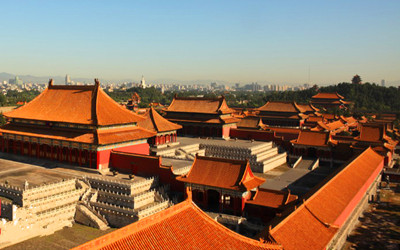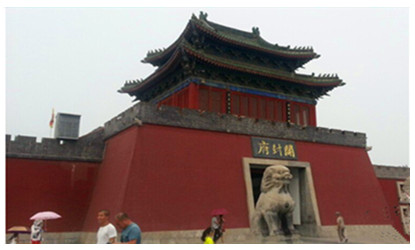After a long period of developement, the ancient Chinese architecture has absorbed the characteristics of other traditional Chinese arts, especially painting, carving, arts and crafts and other plastic arts, which creates a colorful artistic image with many characteristics in this regard. The art characteristics of ancient Chinese architecture are many listed as below:
The ancient Chinese architecture is beautiful and graceful in appearance with distinctive features. Buildings are usually built in square, round, hexagon and octagon; key architectures are standing on platforms, a grand palace even on a three-layered platform, e.g. the Hall of Supreme Harmony in the Forbidden City.
The shapes of the roofs are rich in styles and artistic value. Slopes in four sides, six sides and eight sides are most common; the eaves with kinds of carvings and warp in different ways are usually make a graceful profile of the building; ridges decorated with carvings and ornaments and tiles in colors are also add the artistic value to the roof. The roofs are designed magnificent is not only for the graceful appearance but also for the great practicality that the wide eaves mostly warp upside can prevent the wood structure and platform from the rains.

Architects in ancient China discovered the possibility of using the roof to achieve artistic effects very early. According to the characteristics of the wooden structure, they created the roof lifting and folding, which made them be some eaves like bird wings and some beautiful curves of the roof. At the same time, they decorated properly at the ridge ends of the roof ridges, and also made the cornice tiles be treated decoratively. The roof ridges often had clay figures of deities and animals including dragon. After the Song Dynasty, they used a large number of glazed tiles to add color and luster to the roof. At the same time, many other roof styles appeared successively, as well as various complex shapes with artistic effects formed by these roofs, which made ancient Chinese architecture in the use of roof forms create an unique artistic image of architecture.
Diverse Decorations
Decorations is particular important in ancient Chinese architecture. The image, color and properties of the fitments and decorations are meticulously chosen to beautify kinds of buildings. Almost every part of the building is well-decorated. The platform and steps equipped with railings and incising; beasts and birds are always set on the shaped eaves; doors and windows are engraved with kinds of colorful images and patterns; even the ceilings are designed into a shaped caisson or decorated formally in traditional patterns. Painting on architecture is a distinctive characteristic as well as an indispensable decoration on formal buildings such as palace and temple, while it is forbidden in civilian houses.

Architects in ancient China were good at using colors in architectural decoration. Because the wood couldn't last for a long period of time, the architects in ancient China adopted the method of painting and tung oil on wood so as to protect the connection between wood and reinforce wood components combine with beauty.
After a long period of practice, ancient Chinese architects had accumulated rich experience in using color. For example, while building palaces and government offices such as
the Beijing Forbidden City,
Chengde Mountain Summer Resort,
Kiafeng Prefecture Mansion,etc, they were very good at using the contrast and harmony of colors. It was often made the warm color of vermilion in the main part of the house which part could often be exposed to sunlight. And it was taken the cool color of green or blue in the shaded part under the eaves of the house.
This puts more emphasis on the warmth of sunlight and the of cool of shed, which forms a pleasing contrast. Especially, they added with golden lines and dots on the under scarlet doors or windows and the under blue-green eaves to make the colorful patterns on the building more lively in order to enhance the decorative effect.
Outbuildings Art
The main ancient Chinese architecture of palaces and temples have some annexes which major function is to set off the main architecture. These outbuildings are called 阙 Que in Chinese. In front of the Forbidden City in
Beijing, there are some outbuildings such as Wumen Gate, Huabiao, Archway, Stone Lion, etc. which are rich in art. Especially, the main ancient Chinese architecture has graceful gardens with Great Artistic Conceptions. Chinese gardens are built gracefully with great artistic conceptions in three kinds, aspire conception, immortal conception and natural conception. Aspire conceptions are mostly in the royal gardens such as most of the scenes in the Old Summer Palace, which are built according to the Confucian theories in philosophy, politics, virtue and moral principles. Immortal conceptions are in some royal gardens and temple gardens that are built according to the theories of Confucians and Taoists that people can be immortals by ascetic practices. Natural conceptions are usually in private gardens built by scholars who follow the thoughts of Chinese philosophers Laozi and
Zhuangzi which thoughts lie in the nature, the balance and integration of human and nature, as well as all creature’s relations.

 Architects in ancient China discovered the possibility of using the roof to achieve artistic effects very early. According to the characteristics of the wooden structure, they created the roof lifting and folding, which made them be some eaves like bird wings and some beautiful curves of the roof. At the same time, they decorated properly at the ridge ends of the roof ridges, and also made the cornice tiles be treated decoratively. The roof ridges often had clay figures of deities and animals including dragon. After the Song Dynasty, they used a large number of glazed tiles to add color and luster to the roof. At the same time, many other roof styles appeared successively, as well as various complex shapes with artistic effects formed by these roofs, which made ancient Chinese architecture in the use of roof forms create an unique artistic image of architecture.
Architects in ancient China discovered the possibility of using the roof to achieve artistic effects very early. According to the characteristics of the wooden structure, they created the roof lifting and folding, which made them be some eaves like bird wings and some beautiful curves of the roof. At the same time, they decorated properly at the ridge ends of the roof ridges, and also made the cornice tiles be treated decoratively. The roof ridges often had clay figures of deities and animals including dragon. After the Song Dynasty, they used a large number of glazed tiles to add color and luster to the roof. At the same time, many other roof styles appeared successively, as well as various complex shapes with artistic effects formed by these roofs, which made ancient Chinese architecture in the use of roof forms create an unique artistic image of architecture. Architects in ancient China were good at using colors in architectural decoration. Because the wood couldn't last for a long period of time, the architects in ancient China adopted the method of painting and tung oil on wood so as to protect the connection between wood and reinforce wood components combine with beauty.
Architects in ancient China were good at using colors in architectural decoration. Because the wood couldn't last for a long period of time, the architects in ancient China adopted the method of painting and tung oil on wood so as to protect the connection between wood and reinforce wood components combine with beauty.  Ask Questions ?
Ask Questions ?